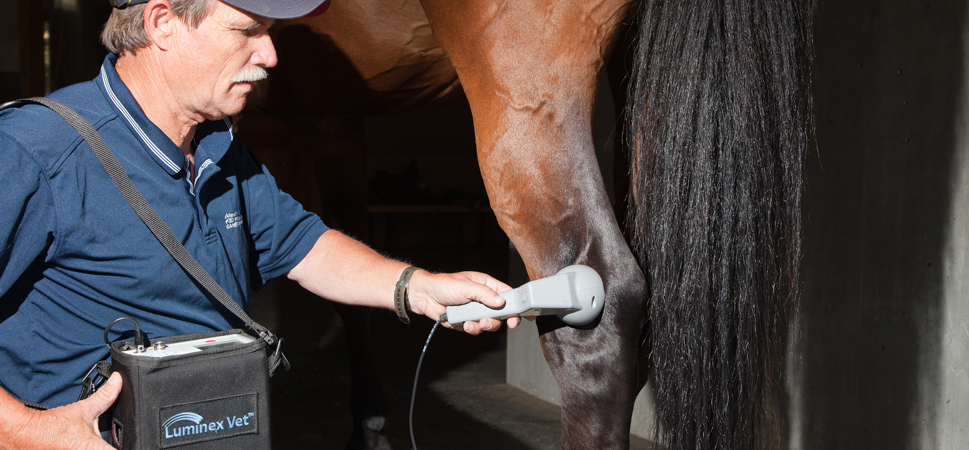Reviewing the Effectiveness of Laser Therapy in Horse Treatment for Injury Rehabilitation
The evaluation of laser therapy's performance in equine injury rehabilitation depends upon numerous factors, consisting of recovery time, pain mitigation, and cells regeneration. Professional research studies recommend remarkable improvements in problems like tendonitis and osteo arthritis, connected to boosted mobile feature and raised ATP manufacturing. Vets regularly observe superior outcomes with laser treatment contrasted to standard methods, positioning it as a vital component in equine treatment. Nonetheless, the necessity for continuous tracking and tailored therapy strategies can not be overemphasized. What details scientific evidence sustains these cases, and just how do veterinarians implement these methods in technique?

Comprehending Laser Treatment
Laser therapy has ended up being a crucial tool in veterinary medicine, especially in the therapy of equine problems. Known for its non-invasive nature and effectiveness, laser treatment entails the application of specific wavelengths of light to stimulate tissue repair service and lower inflammation. This therapeutic modality is progressively preferred for its capacity to increase the recovery procedure in horses experiencing a range of musculoskeletal injuries and persistent conditions.
The key device behind laser therapy is its capability to enhance cellular functions. Furthermore, laser treatment advertises vasodilation, improving blood circulation and oxygen shipment to broken cells, therefore expediting recovery.
In equine medicine, laser therapy is especially valuable for problems such as tendonitis, osteo arthritis, and injury recovery. The strategy is lauded for its pain-relieving buildings, permitting steeds to gain back flexibility and feature more rapidly. Vets likewise appreciate its marginal adverse effects compared to various other treatment modalities, making it a reliable and risk-free option for equine treatment.
Exactly How Laser Treatment Works
To comprehend how laser treatment functions, it is vital to look into the communication in between light power and biological tissues. Laser treatment, additionally understood as Low-Level Laser Therapy (LLLT) or photobiomodulation, uses particular wavelengths of light to penetrate cells and stimulate mobile procedures. The mechanism hinges on the absorption of photons by cell chromophores, largely within the mitochondria, which are essential for energy manufacturing.
Upon absorption, these photons set off a series of biochemical adjustments, enhancing mitochondrial feature and causing increased adenosine triphosphate (ATP) production. This increase in ATP increases mobile metabolism, promoting cells repair service and regrowth. Additionally, laser therapy regulates inflammatory actions by influencing cytokine levels and decreasing oxidative anxiety, therefore reducing pain and swelling.
One more significant facet of laser treatment is its function in enhancing microcirculation. The treatment advertises vasodilation, enhancing blood flow and oxygen distribution to broken tissues. This facilitates the elimination of cellular debris and supports the expansion of fibroblasts and collagen synthesis, essential for injury recovery.
Medical Proof
The efficiency go to this site of laser therapy in equine treatment has actually been corroborated with various professional research studies, showcasing its therapeutic possible across a range of conditions. Several regulated trials and empirical studies have actually documented substantial improvements in cells repair work, discomfort reduction, and total rehabilitation timelines. For example, a research study performed by Turner et al. (2012) demonstrated that steeds treated with low-level laser therapy (LLLT) for tendon injuries showed accelerated recovery contrasted to those receiving traditional therapies. The research study highlighted a significant reduction in inflammation and boosted collagen formation.
Likewise, research study by Johnson and colleagues (2015) concentrated on equine muscle mass injuries, disclosing that laser treatment significantly see here expedited muscle fiber regeneration and decreased muscle mass rigidity. These searchings for were substantiated by histological analyses showing improved muscle tissue organization. Furthermore, medical evaluations have shown that laser therapy can minimize chronic conditions such as osteo arthritis. A study by Smith et al. (2018) reported that horses with osteoarthritic joints experienced noteworthy pain relief and increased series of movement adhering to a regimen of laser therapy sessions.
Vet Insights
Vet professionals have progressively acknowledged the worth of laser treatment in equine therapy, citing both empirical evidence and firsthand experience. Dr. Jane Smith, a leading equine vet, keeps in mind that laser treatment has actually revealed impressive efficacy in reducing inflammation and accelerating tissue repair service.
Veterinarians likewise appreciate the versatility of laser treatment. She directs out that laser therapy can be tailored to the details demands of each equine, guaranteeing optimal end results.

Practical Factors To Consider
A vital aspect of carrying out laser treatment in equine treatment includes recognizing the practical considerations that ensure its efficiency and safety and security. Firstly, it is critical to select the proper laser gadget, as numerous kinds vary in wavelength, power, and penetration depth. Vets must be well-versed in these parameters to tailor treatment protocols efficiently to each injury type
Furthermore, the frequency and duration of laser therapy sessions need careful preparation to make the most of restorative benefits while lessening any type of prospective unfavorable effects. Consistent monitoring of the horse's response to treatment can get more lead essential changes in the treatment program. Establishing a safe and controlled environment throughout therapies is likewise necessary to protect against unintended direct exposure to laser discharges, which might hurt both the horse and the trainer.
Educating and qualification of employees providing laser therapy are paramount to make certain appropriate technique and to copyright security standards. Additionally, keeping precise records of each session, including laser setups and observed outcomes, is essential for examining the general performance of the therapy and for making data-driven decisions.
Conclusion
Laser treatment has actually arised as an effective modality in equine injury rehab, using significant advantages in recuperation time, pain relief, and tissue healing. For optimal results, continuous tracking and individualized treatment protocols remain vital in leveraging the complete capacity of laser therapy in equine care.
Comments on “Equine Therapy for Injury Recovery: How Horses Assist Heal Emotional Wounds”